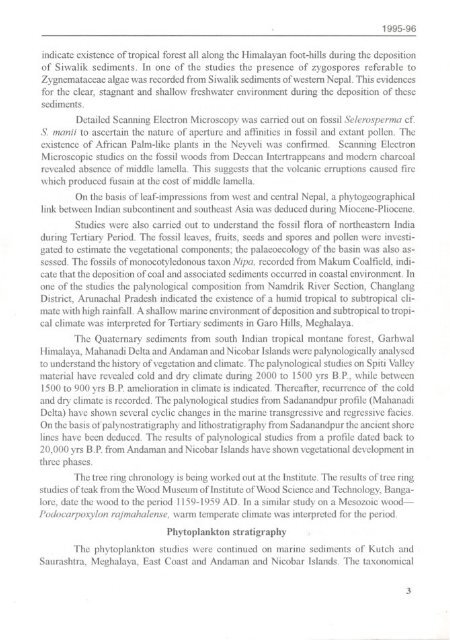1995-96 - Birbal Sahni Institute of Palaeobotany
1995-96 - Birbal Sahni Institute of Palaeobotany
1995-96 - Birbal Sahni Institute of Palaeobotany
You also want an ePaper? Increase the reach of your titles
YUMPU automatically turns print PDFs into web optimized ePapers that Google loves.
<strong>1995</strong>-<strong>96</strong><br />
indicate existence <strong>of</strong> tropical forest all along the Himalayan foot-hills during the deposition<br />
<strong>of</strong> Siwalik sediments. In one <strong>of</strong> the studies the presence <strong>of</strong> zygospores referable to<br />
Zygnemataceae algae was recorded from Siwalik sediments <strong>of</strong> western Nepal. This evidences<br />
for the clear. stagnant and shallow freshwater environment during the deposition <strong>of</strong> these<br />
sediments.<br />
Detailed Scanning Elcctron Microscopy was carried out on fossil Selerosperma cf.<br />
S. manii to ascertain the nature <strong>of</strong> aperture and affinities in fossil and extant pollen. The<br />
existence <strong>of</strong> African Palm-like plants in the Neyvcli was ·confinned. Scanning Electron<br />
Microscopic studies on the fossil woods from Deccan Intertrappeans and modem charcoal<br />
revealed absence <strong>of</strong> middle lamella. This suggests that the volcanic erruptions caused fire<br />
which produced fusain at the cost <strong>of</strong> middle lamella.<br />
On the basis <strong>of</strong> leaf-impressions from west and central Nepal, a phytogeographical<br />
link between Indian subcontinent and southeast Asia was deduced during Miocene-Pliocene.<br />
Studies were also carried out to understand the fossil flora <strong>of</strong> northeastern India<br />
during Tertiary Period. The fossil leaves, fruits, seeds and spores and pollen were investigated<br />
to estimate the vegetational components; the palaeoecology <strong>of</strong> the basin was also assessed.<br />
The fossils <strong>of</strong> monocotyledonous taxon Nipa. recorded from Makum Coalfield, indicate<br />
that the deposition <strong>of</strong> coal and associated sediments occurred in coastal environment. In<br />
one <strong>of</strong> the studies the palynological composition from Namdrik River Section, Changlang<br />
District, Arunachal Pradesh indicated the existence <strong>of</strong> a humid tropical to subtropical climate<br />
with high rainfall. A shallow marine environment <strong>of</strong> deposition and subtropical to tropical<br />
climate was interpreted for Tertiary sediments in Garo Hills, Meghalaya.<br />
The Quaternary sediments from south Indian tropical montane forest, Garhwal<br />
Himalaya, Mahanadi Delta and Andaman and Nicobar Islands were palynologically analysed<br />
to understand the history <strong>of</strong> vegetation and climate. The palynological studies on Spiti Valley<br />
material have revealed cold and dry c1innateduring 2000 to 1500 yrs B.P., while between<br />
1500 to 900 yrs B.P. amelioration in climate is indicated. Thereafter, recurrence <strong>of</strong> the cold<br />
and dry climate is recorded. The palynological studies from Sadanandpur pr<strong>of</strong>ile (Malmnadi<br />
Delta) have shown several cyclic changes in the marine transgressive and regressive facies.<br />
On the basis <strong>of</strong> palynostratigraphy and lithostratigraphy from Sadanandpur the ancient shore<br />
lines have been deduced. The results <strong>of</strong> palynological studies from a pr<strong>of</strong>ile dated back to<br />
20,000 yrs B.P. from Andaman and icobar Islands have shown vegetational development in<br />
three phases.<br />
The tree ring chronology is being worked out at the <strong>Institute</strong>. The results <strong>of</strong> tree ring<br />
studies <strong>of</strong> teak from the Wood Museul11<strong>of</strong> <strong>Institute</strong> <strong>of</strong> Wood Science and Technology, Bangalore,<br />
date the wood to the period 1159-1959 AD. In a similar study on a Mesozoic wood<br />
Podocarpoxylon rajmahalense, wann temperate climate was interpreted for the period.<br />
Phytoplankton<br />
stratigraphy<br />
The phytoplankton studies were continued on marine sediments <strong>of</strong> Kutch and<br />
Saurashtra, Meghalaya. East Coast and Andaman and Nicobar Islands. The taxonomical<br />
3

















